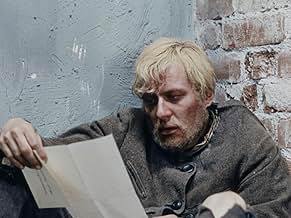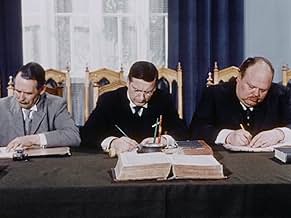Täällä Pohjantähden alla
- 1968
- 3 h 6 min
Adicionar um enredo no seu idiomaTäällä Pohjantähden alla is based on the book with the same title. It is a story of the little village. The movie starts in the 1890's and it ends to the Finnish civil war in 1918. Story con... Ler tudoTäällä Pohjantähden alla is based on the book with the same title. It is a story of the little village. The movie starts in the 1890's and it ends to the Finnish civil war in 1918. Story concentrates around a tenant farmer family, although it gives us a good look at the society a... Ler tudoTäällä Pohjantähden alla is based on the book with the same title. It is a story of the little village. The movie starts in the 1890's and it ends to the Finnish civil war in 1918. Story concentrates around a tenant farmer family, although it gives us a good look at the society at whole. While the class struggle depends, people of the village are driven to bloody civi... Ler tudo
- Direção
- Roteiristas
- Artistas
- Prêmios
- 4 vitórias no total
Avaliações em destaque
The movie and novel it's based upon are both important, since they bring out the viewpoint of the losing side of the civil war, into which the social changes eventually led. Finnish people bore the scars of the civil war for many decades, and this novel was the first one to take upon the task of healing those scars.
The working class is being pressed on the edge. They are barely more than serfs and have no means of claiming the land they're cultivating and taking care of. The conditions in Finland are fluctuating at best, since the country is still an autonomic part of Russia with it's sovereign rights being disputed. The movie tells of a certain Koskela family trying to make a secure living under these circumstances on the fields they've cleared of the swamps and in the house they built from trees growing in the forests.
Each and every Finn should watch this movie to understand their own roots a lot better!
The story, starting just before Finland gains its independence, is a multi-generation spanning history of a newly independent nation dealing with inner turmoil, told through the eyes of a little community, with an emphasis on the Koskela-family. The first half of the film is set around Jussi Koskela, a poor, mild-mannered man who's trying to get ahead in life, while the second half mostly revolves around Jussi's son: Akseli, a passionate and fiery-tempered young man also trying to get ahead in life, but by far more radical ways than his father. The main theme is the class struggle between the rich and the poor (the "whites" and the "reds") which would eventually escalate to a full-blown, bitter, civil war. Although not forgetting the joys of life, like in the form of the tender romance between Akseli and Elina.
While the examination of what lead to the conflict is equally important, the civil war takes the major part of the film. What makes this the definitive portrait of the war, is that, while it is told from the reds' point-of-view, it doesn't "choose sides", rather just documents a national tragedy. Atrocities and war crimes toward civilians are done by both sides and the "trials" held during and after the war are more about settling personal vendettas than actually passing justice. Incidentally the best moments of the movie are in the last quarter when the drama reaches its harrowing and heartbreaking conclusion.
Most of the films excellence must be attributed to the masterful source novel, but even so, just the fact that this is so well adapted is praiseworthy in itself. The essential parts of the book have translated well to the screen (in content, but also in Linna's slyly sardonic tone) and the pacing is excellent, the film moves on a brisk pace for a 190 minute epic. It's visually appealing, not exactly stunning, but definitely well-shot and musically memorable. On the other hand, the films major weakness lies in the badly dated acting. The main players are all solid; some, like Aarno Sulkanen (as Akseli) are even great; but unfortunately many of the minor players range from plain hammy to grating "scenery-chewing", but that one complaint aside, the film is captivating, incredibly touching, unforgettable achievement..
Finnish cinema does not get more essential than this. If you ever have the chance to see it I highly recommend giving it a try.
The first part of the film marches on at breakneck speed. As some 20 years of story are compressed into roughly one hour of film, there are some jarring time jumps if you do not know the book, lack the historical knowledge, or simply fail to pay attention to every scene. The tone of the film is also something to be praised. It starts with light-hearted though dramatic scenes, with plenty of humorous exchanges and musical scores. Once the civil war breaks out, this lightness is tossed out and the horrible events are depicted almost without any score, in a matter-of-fact, documentary-style.
"Täällä Pohjantähden Alla" is a classic that everyone should see at least once.
Você sabia?
- CuriosidadesNight battle scene at the end of the movie is based on thrue events at the battle of Syrjäntaka at Tuulos, Finland. This battle was fought between Finnish Red Guards and Imperial German forces at April 28-29 1918.
- ConexõesEdited into Pohjantähti (1973)
- Trilhas sonorasAkselin ja Elinan häävalssi
Written by Heikki Aaltoila
Principais escolhas
- How long is Here, Beneath the North Star?Fornecido pela Alexa
Detalhes
Bilheteria
- Orçamento
- FIM 900.000 (estimativa)
- Tempo de duração3 horas 6 minutos
- Mixagem de som
- Proporção
- 1.78 : 1
Contribua para esta página





















